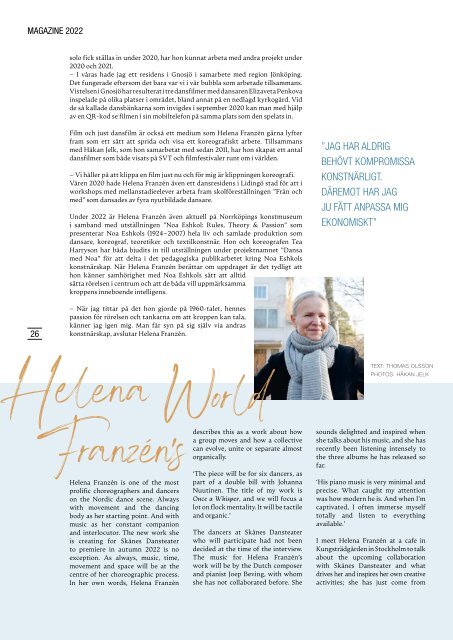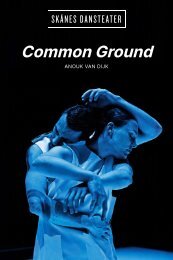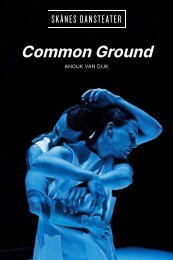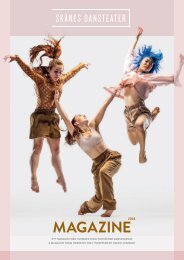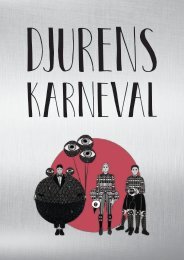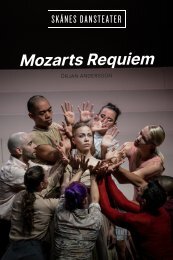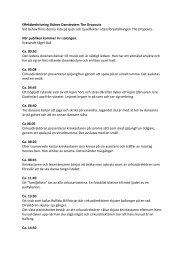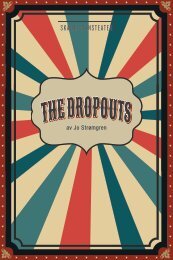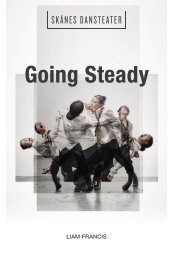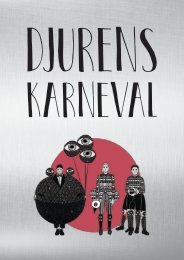Skånes Dansteater Magazine 2022
Skånes Dansteaters magasin om dansen, föreställningarna, mötena och konstnärerna som väntar på Sveriges enda fristående dansinstitution. Skånes Dansteater's Magazine 2022 about the dance, the performances, the artists, the encounters and the artists we are hosting during 2022.
Skånes Dansteaters magasin om dansen, föreställningarna, mötena och konstnärerna som väntar på Sveriges enda fristående dansinstitution.
Skånes Dansteater's Magazine 2022 about the dance, the performances, the artists, the encounters and the artists we are hosting during 2022.
You also want an ePaper? Increase the reach of your titles
YUMPU automatically turns print PDFs into web optimized ePapers that Google loves.
MAGAZINE <strong>2022</strong><br />
ONCE A WHISPER, FRANZÉN/NUUTINEN<br />
26<br />
solo fick ställas in under 2020, har hon kunnat arbeta med andra projekt under<br />
2020 och 2021.<br />
– I våras hade jag ett residens i Gnosjö i samarbete med region Jönköping.<br />
Det fungerade eftersom det bara var vi i vår bubbla som arbetade tillsammans.<br />
Vistelsen i Gnosjö har resulterat i tre dansfilmer med dansaren Elizaveta Penkova<br />
inspelade på olika platser i området, bland annat på en nedlagd kyrkogård. Vid<br />
de så kallade dansbänkarna som invigdes i september 2020 kan man med hjälp<br />
av en QR-kod se filmen i sin mobiltelefon på samma plats som den spelats in.<br />
Film och just dansfilm är också ett medium som Helena Franzén gärna lyfter<br />
fram som ett sätt att sprida och visa ett koreografiskt arbete. Tillsammans<br />
med Håkan Jelk, som hon samarbetat med sedan 2011, har hon skapat ett antal<br />
dansfilmer som både visats på SVT och filmfestivaler runt om i världen.<br />
– Vi håller på att klippa en film just nu och för mig är klippningen koreografi.<br />
Våren 2020 hade Helena Franzén även ett dansresidens i Lidingö stad för att i<br />
workshops med mellanstadieelever arbeta fram skolföreställningen ”Från och<br />
med” som dansades av fyra nyutbildade dansare.<br />
Under <strong>2022</strong> är Helena Franzén även aktuell på Norrköpings konstmuseum<br />
i samband med utställningen ”Noa Eshkol: Rules, Theory & Passion” som<br />
presenterar Noa Eshkols (1924–2007) hela liv och samlade produktion som<br />
dansare, koreograf, teoretiker och textilkonstnär. Hon och koreografen Tea<br />
Harryson har båda bjudits in till utställningen under projektnamnet ”Dansa<br />
med Noa” för att delta i det pedagogiska publikarbetet kring Noa Eshkols<br />
konstnärskap. När Helena Franzén berättar om uppdraget är det tydligt att<br />
hon känner samhörighet med Noa Eshkols sätt att alltid<br />
sätta rörelsen i centrum och att de båda vill uppmärksamma<br />
kroppens inneboende intelligens.<br />
– När jag tittar på det hon gjorde på 1960-talet, hennes<br />
passion för rörelsen och tankarna om att kroppen kan tala,<br />
känner jag igen mig. Man får syn på sig själv via andras<br />
konstnärskap, avslutar Helena Franzén.<br />
elena World<br />
Franzén ' s<br />
Helena Franzén is one of the most<br />
prolific choreographers and dancers<br />
on the Nordic dance scene. Always<br />
with movement and the dancing<br />
body as her starting point. And with<br />
music as her constant companion<br />
and interlocutor. The new work she<br />
is creating for Skånes <strong>Dansteater</strong><br />
to premiere in autumn <strong>2022</strong> is no<br />
exception. As always, music, time,<br />
movement and space will be at the<br />
centre of her choreographic process.<br />
In her own words, Helena Franzén<br />
describes this as a work about how<br />
a group moves and how a collective<br />
can evolve, unite or separate almost<br />
organically.<br />
‘The piece will be for six dancers, as<br />
part of a double bill with Johanna<br />
Nuutinen. The title of my work is<br />
Once a Whisper, and we will focus a<br />
lot on flock mentality. It will be tactile<br />
and organic.’<br />
The dancers at Skånes <strong>Dansteater</strong><br />
who will participate had not been<br />
decided at the time of the interview.<br />
The music for Helena Franzén’s<br />
work will be by the Dutch composer<br />
and pianist Joep Beving, with whom<br />
she has not collaborated before. She<br />
”JAG HAR ALDRIG<br />
BEHÖVT KOMPROMISSA<br />
KONSTNÄRLIGT.<br />
DÄREMOT HAR JAG<br />
JU FÅTT ANPASSA MIG<br />
EKONOMISKT”<br />
TEXT: THOMAS OLSSON<br />
PHOTOS: HÅKAN JELK<br />
sounds delighted and inspired when<br />
she talks about his music, and she has<br />
recently been listening intensely to<br />
the three albums he has released so<br />
far.<br />
‘His piano music is very minimal and<br />
precise. What caught my attention<br />
was how modern he is. And when I’m<br />
captivated, I often immerse myself<br />
totally and listen to everything<br />
available.’<br />
I meet Helena Franzén at a cafe in<br />
Kungsträdgården in Stockholm to talk<br />
about the upcoming collaboration<br />
with Skånes <strong>Dansteater</strong> and what<br />
drives her and inspires her own creative<br />
activities; she has just come from<br />
Skeppsholmsstudion, a dance studio<br />
she shares with a few colleagues in<br />
Stockholm. The week before she held<br />
a workshop, ‘Embodied Awareness’,<br />
at Danscentrum Väst in Gothenburg.<br />
‘What drives me is a desire to share.<br />
It can take the form of mentoring,’<br />
says Helena Franzén, who for many<br />
years has also taught and created<br />
new works with students at the Royal<br />
Swedish Ballet School in Stockholm.<br />
And it’s obvious when she talks<br />
about her activities that she certainly<br />
has a strong urge to pass on the<br />
experiences that she and those she<br />
has collaborated with have gathered<br />
in their practice.<br />
She talks with as much warmth and<br />
passion about the young dancers<br />
she has worked with as she does<br />
about those with whom she has<br />
collaborated over longer periods.<br />
‘I’ve never needed to compromise<br />
artistically. Although I have had to<br />
make adjustments financially,’ she<br />
says, and adds that she wants the<br />
dancers and others she works with to<br />
get a reasonable fee from her as their<br />
employer.<br />
Dance, like all performing arts, is in<br />
great need of active history writing<br />
or, more precisely, knowledge<br />
sharing, in view of its transient<br />
nature as an art form. For what is<br />
left after the performance, if the<br />
memories and physical experiences<br />
of the participating dancers and<br />
choreographer are not upcycled<br />
in some way? We also discuss the<br />
importance of writing and talking<br />
about art, regardless of whether it<br />
is happening now or forms part of<br />
contemporary dance history.<br />
A couple of years ago, she and the<br />
photographer and filmmaker Håkan<br />
Jelk summarised her first 30 years<br />
as a dancer and choreographer in<br />
the comprehensive exhibition Mitt<br />
dansande liv (My Dancing Life) at<br />
Dansmuseet in Stockholm. Her<br />
background as a dancer in Margaretha<br />
Åsberg’s Pyramiderna is obviously<br />
included in the exhibition, which<br />
after Dansmuseet toured to Tampere<br />
in Finland and Lidingö Town Hall in<br />
Stockholm. Mitt Dansande Liv revealed<br />
how consistently she has moved<br />
on and deepened her choreographic<br />
movement material. But also the<br />
significance of collaborations and<br />
how she has alternated commissions<br />
from various institutions with her<br />
own productions over the years.<br />
When I ask her what the biggest<br />
difference is between working on her<br />
own projects and with institutions<br />
such as Skånes <strong>Dansteater</strong>, she<br />
instantly replies:<br />
‘I get to be a choreographer! Otherwise<br />
I have to do everything myself. Just<br />
having access to a costume department<br />
is fantastic.’<br />
Her long experience as a freelance<br />
choreographer, she thinks, probably<br />
helped her get through the<br />
long period of massive covid-19<br />
restrictions on the performing arts<br />
relatively unscathed. Even though<br />
she had to cancel a tour to Tokyo with<br />
a new solo in 2020, she has been able<br />
to carry on working on other projects<br />
in 2020 and 2021.<br />
‘This spring, we had a residency<br />
in Gnosjö, courtesy of Region<br />
Jönköping. We could do it because<br />
it was just us in our bubble, working<br />
together.’<br />
The Gnosjö session resulted in three<br />
dance films with the dancer Elizaveta<br />
Penkova, recorded at different locations<br />
in the area, including a<br />
disused graveyard. At the so-called<br />
dance benches that were inaugurated<br />
in September 2020, viewers can scan<br />
a QR code to see the film in their<br />
mobile phones in the same spot where<br />
it was made.<br />
Film, and particularly dance film,<br />
is a medium that Helena Franzén<br />
highlights as a way to share and show<br />
choreographic works. She and Håkan<br />
Jelk, with whom she has collaborated<br />
since 2011, have made several dance<br />
films that have been shown on SVT<br />
and at film festivals all over the world.<br />
‘We are editing a film right now, and<br />
to me editing is choreography.’<br />
In spring 2020, Helena Franzén was<br />
also a dancer in residence in Lidingö,<br />
organising workshops for middle<br />
school children to create a school<br />
production, Från och med (From and<br />
With), performed by four recent<br />
dance graduates.<br />
In <strong>2022</strong>, Helena Franzén will also<br />
be in the spotlight at Norrköpings<br />
Konstmuseum in connection with the<br />
exhibition Noa Eshkol: Rules, Theory<br />
& Passion, presenting Noa Eshkol’s<br />
(1924–2007) entire life and collected<br />
output as a dancer, choreographer,<br />
theoretician and textile artist. Both<br />
she and the choreographer Tea<br />
Harryson were invited to this project<br />
named Dansa med Noa (Dance with<br />
Noa) to contribute to the educational<br />
activities for visitors concerning<br />
Noa Eshkol’s artistic practice. When<br />
Helena Franzén talks about it, there<br />
is no doubting her sense of kinship<br />
with Noa Eshkol’s way of consistently<br />
putting movement in the centre, and<br />
that they both want to acknowledge<br />
the inherent intelligence of the body.<br />
‘When I look at what she did in the<br />
1960s, her passion for movement and<br />
her ideas about the body’s ability<br />
to speak, it resonates with me. The<br />
artistic practice of others makes<br />
you see yourself,’ Helena Franzén<br />
concludes.<br />
SKÅNES DANSTEATER


